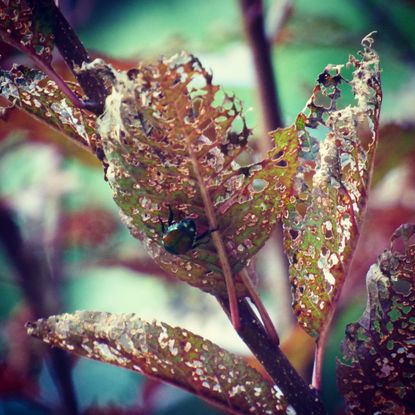Skeletonized Plant Leaves: Causes For Skeletonization Of Leaves


Leaf problems abound in the home landscape but nothing is more puzzling than the causes of skeletonization. Skeletonized plant leaves are but a shadow of themselves, with window panes of damage throughout the leaf. The reasons for skeletonizing leaves may stem from insect or disease and occasionally chemical injury. Most common are insect pests whose feeding behavior is along the veins of the foliage. Recognize the signs of these pests so you can control them and prevent skeletonized leaf damage.
Assessing Skeletonized Leaf Damage
Plants use their leaves to harvest solar energy, which they then turn into carbohydrates for fuel. The process, photosynthesis, relies upon open leaf surfaces filled with chlorophyll. When there are numerous skeletonized plant leaves, overall vigor is significantly reduced. It also doesn't help the appearance of prized foliage plants whose presence in the garden is due to their spectacular leaf displays. One of the primary reasons for skeletonizing leaves is larval feeding. The adult species can be easily recognized in order to control them and minimize egg laying. Once hatched, larvae may be harder to control and prevent leaf damage. One of the first plants you might notice with skeletonization of leaves is the rose. These are pretty tasty to the adults and larvae of:
These pests will also chomp on the foliage of other ornamental plants and there are also specialized pests such as the viburnum leaf beetle. The damage is characteristic and looks nothing like other leaf damage, such as that posed by leaf cutter bees. The lacy holes run next to the heavy veins in the leaf, lending it a snowflake pattern, with no leaf identical. Heavy damage may require pesticides but, in most cases, the answer is much simpler.
Preventing Skeletonized Leaves on Plants
Skeletonization of leaves also occurs on an array of other plants, like hibiscus and ornamental plums, and is often the calling card of adult as well as larvae. To minimize adult populations, handpicking is a safe and non-toxic method. Get a flashlight and go out after dark to find some of the culprits. Others will be brazenly dining in broad daylight. Treatment is simple. Squash the little pests. Chemical treatments are not usually effective on adults, but are more useful on soft bodied larvae. If you can minimize the adult population, the larvae will be in short supply and it is possible to control them by hand in small gardens. Larger landscapes with plenty of tasty ornamentals will need to rely upon chemical control.
Chemical Treatment of Skeletonized Leaves on Plants
Natural chemical treatments are the healthiest option for the garden. Neem or horticultural grade oil, insecticidal soap and blasts of water to remove the insects and their larvae are often effective. Larvae are most effected when treated young in the spring and early summer. Bacillus thuringiensis may prove to control many of the larvae. It is a naturally occurring bacterium that is not harmful to most beneficial insects. The most effective way to stop skeletonization of leaves is to get out into the garden every day and look for damage. Jump on the treatment of your choice as soon as possible to save your plant's foliage and health.
Gardening tips, videos, info and more delivered right to your inbox!
Sign up for the Gardening Know How newsletter today and receive a free download of our most popular eBook "How to Grow Delicious Tomatoes."

Bonnie Grant is a professional landscaper with a Certification in Urban Gardening. She has been gardening and writing for 15 years. A former professional chef, she has a passion for edible landscaping.
-
 Urban Beekeeping Guide: Top Tips For Raising Bees In The City
Urban Beekeeping Guide: Top Tips For Raising Bees In The CityUrban beekeeping can be a rewarding and appreciated pastime, but first be sure it’s legal in your city and learn the ropes of beekeeping.
By Mary Ellen Ellis
-
 2024 Plant Of The Year: Why Experts Say Philodendron Is The “It” Plant Of The Year
2024 Plant Of The Year: Why Experts Say Philodendron Is The “It” Plant Of The YearWe aren’t surprised that philodendron was designated the plant of the year. Versatile, easy-care and lovely, it’s the houseplant of the year 2024!
By Bonnie L. Grant